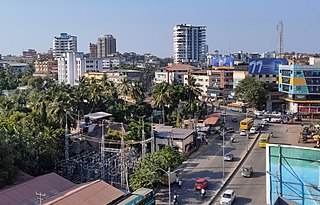
A brick is a type of construction material used to build walls, pavements and other elements in masonry construction. Properly, the term brick denotes a unit primarily composed of clay, but is now also used informally to denote units made of other materials or other chemically cured construction blocks. Bricks can be joined using mortar, adhesives or by interlocking. Bricks are usually produced at brickworks in numerous classes, types, materials, and sizes which vary with region, and are produced in bulk quantities.

Mangalore, officially known as Mangaluru, is a major port city in the Indian state of Karnataka & on the west coast of India. It is located between the Arabian Sea and the Western Ghats about 352 km (219 mi) west of Bangalore, the state capital, 20 km north of Karnataka–Kerala border, 297 km south of Goa. Mangalore is the state's only city to have all four modes of transport—air, road, rail and sea. The population of the urban agglomeration was 619,664 according to the 2011 national census of India. It is known for being one of the locations of the Indian strategic petroleum reserves.

Tiles are usually thin, square or rectangular coverings manufactured from hard-wearing material such as ceramic, stone, metal, baked clay, or even glass. They are generally fixed in place in an array to cover roofs, floors, walls, edges, or other objects such as tabletops. Alternatively, tile can sometimes refer to similar units made from lightweight materials such as perlite, wood, and mineral wool, typically used for wall and ceiling applications. In another sense, a tile is a construction tile or similar object, such as rectangular counters used in playing games. The word is derived from the French word tuile, which is, in turn, from the Latin word tegula, meaning a roof tile composed of fired clay.

Linguiça or lingüiça is a Brazilian and Portuguese sausage made from pork and seasoned with onion, garlic, paprika and other spices. It can be eaten fresh after being prepared or undergo a curing and conservation process through smoking.

Dakshina Kannada district is a district of Karnataka state in India, with its headquarters in the coastal city of Mangalore. It is part of the larger Tulu Nadu region. The district covers an area nestled in between the Western Ghats to its east and the Arabian Sea to its west. Dakshina Kannada receives abundant rainfall during the Indian monsoon. It is bordered by Udupi district to the north, Chikmagalur district to the northeast, Hassan district to the east, Kodagu to the southeast and Kasaragod district of Kerala to the south. According to the 2011 census of India, Dakshina Kannada district had a population of 2,083,625. It is the only district in Karnataka state to have all modes of transport like road, rail, water and air due to the presence of a major hub, Mangalore. This financial district is also known as the Cradle of Indian banking.
Mangalorean Catholics are an ethno-religious community of Latin Catholics in India typically residing in the Diocese of Mangalore in the erstwhile South Canara area, by the southwestern coast of present-day Karnataka.

St. Aloysius Chapel, or the chapel of St. Aloysius College, is a Christian chapel in Mangalore in the state of Karnataka in southwest India. The Chapel is situated in the heart of the city on the Lighthouse Hill.

Father Jerome D'Souza, SJ was an Indian Jesuit priest, educationist, writer and member of the Indian Constituent assembly (1946–50).
Roman Catholic Brahmin is a caste among the Goan, Bombay East Indian and Mangalorean Catholics who are patrilineal descendants of Konkani Brahmin converts to the Latin Catholic Church, in parts of the Konkan region that were annexed into the Portuguese East Indies, with the capital (metropole) at Velha Goa, while Bombay was the largest territory (province). They retain some of the ethno-social values and customs of their ancestors, and most of them exhibit a noticeable hybrid Latino-Concanic culture. They were known as the Brahmins among the "New Christians".

Mangalore tiles are a type of tile native to the city of Mangalore, India. Typically considered to be a part of Spanish and Italian architectural styles, the tiles were first introduced to India in 1860 by German missionaries of the Basel Mission of Switzerland, who also established weaving enterprises. Since that time, the industry has flourished in India with these red tiles, prepared from hard laterite clay, in great demand throughout the country. They are exported to Myanmar, Sri Lanka, and the Far East and even as far as East Africa, the Middle East, Europe, and Australia. These were the only tiles recommended for government buildings in India under the British Raj.
Albuquerque tile factory is a tile factory located currently at Hoige Bazaar, Bolar, Mangalore, Karnataka, India. It is the only tile factory whose tiles are recommended for Government buildings.
The culture of Mangalorean Catholics has been shaped by their Christianisation in Goa, their migrations& their captivity. They adopted elements of the local Mangalorean culture, but retained many of their Konkani customs and values. The ethnic Mangalorean houses of the older generation have spacious porticos, red oxide cemented floors, terra cotta roofs layered with the once famous Mangalore tiles. The houses are usually accompanied by their own private wells or ponds, and are normally attached to orchards of coconut trees, jackfruit trees, ice apple trees, Alphonso mango trees, areca nut trees etc.
The History of Mangalorean Catholics comprises three major eras. The first era consists of the cultural heritage shaped by Indo-Aryan migration into the Indus valley, later the migration to Govapuri and other prominent areas of the Konkan region, possibly due to a natural disaster that caused the drying up of the Sarasvati. Also, the various invasions and the political upheavals that followed in the pre-Partition eras of the northwest Indian subcontinent might be responsible for migration to Konkan in Western India. The second era was the legacy of Lusitanian culture, from the conversion of their Konkani ancestors to Roman Catholicism in the colonies of the Portuguese in Goa and Bombay-Bassein, and the final era being the migration of the Roman Catholics in Goa to Mangalore and other parts of South Canara between the mid-16th and mid-18th centuries, forming a unique Mangalorean Catholic identity, and the subsequent growth and development of the community. Several centuries of living in South Canara gave these Catholics an identity of their own.

The Mangalorean Catholic Cuisine is the cuisine of the Mangalorean Catholic community.
The Captivity of Mangalorean Catholics at Seringapatam (1784–1799) was a 15-year imprisonment of Mangalorean Catholics and other Christians at Seringapatam, in the Carnataca region of India by Tippu Sultan, the de facto ruler of the Kingdom of Mysore. Estimates of the number of captives range from 30,000 to 80,000, but the generally accepted figure is 60,000, as stated by Tipu in the Sultan-ul-Tawarikh. The captivity was the most disconsolate period in the community's history.
Alvares tile factory is a Mangalore tile factory in Mangalore. The tiles produced by this factory were in great demand throughout the Indian subcontinent and East Africa.

Church of Our Lady of Rosary of Mangalore, or Rosario Cathedral is a Roman Catholic cathedral in the Roman Catholic Diocese of Mangalore, dedicated to Our Lady of the Rosary. It was the first Roman Catholic church in the Canara region. Historically, this was the only parish church in Mangalore reserved for the high-caste Mangalorean Catholics. It is the oldest church in Karnataka.

Monti Fest is a major Catholic festival held on 8 September every year by the Latin Catholic community of Konkani people, originating in the Konkan region of India, and their descendants in the Canara region of south India. This festival celebrates the Nativity of the Blessed Virgin Mary and in the Mangalorean Catholic community involves blessing of Novem. In certain Goan Catholic dialects the festival's name is corrupted to "Moti Fest".
Participation of Mangalorean Catholics in the Indian Independence Movement recounts the community's role in the Indian Independence Movement.

Roof tiles are designed mainly to keep out rain, and are traditionally made from locally available materials such as terracotta or slate. Modern materials such as concrete, metal and plastic are also used and some clay tiles have a waterproof glaze.














